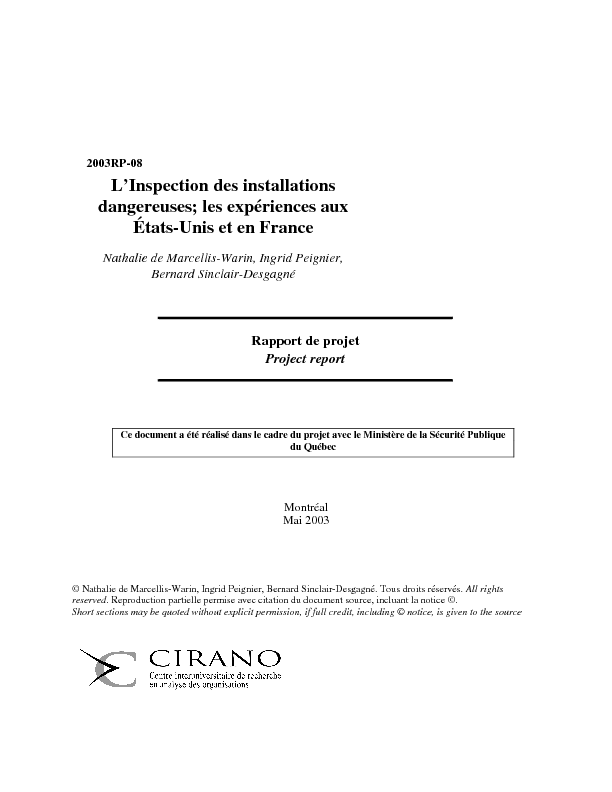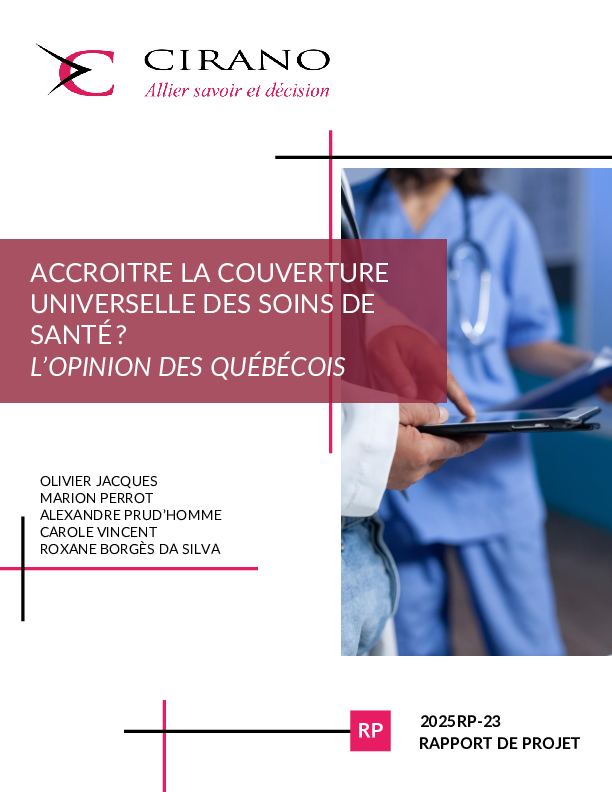L'Inspection des installations dangereuses; les expériences aux États-Unis et en France
As a new regulation comes into effect, a program of inspection must be set up to guarantee that the requirements are completed by the subjected facilities. Then the facilities must make the necessary corrective actions within reasonable times. Various questions arise when we evoke the subject of inspection, namely, who will carry out the inspections, at which frequency the facilities will be inspected, on which criteria?
First of all, we describe general notions of the inspection of dangerous facilities. We highlight how inspection can be characterized by two elements: its probability and its actors. That comes to determine the design of an inspection, that is to say when the inspection must be conducted and the type of inspection selected (independent auditors, responsible care?). From an economic point of view, the threat of inspection must be credible so that the installations could see incentives to be in compliance with the regulation. Inspection is generally carried out by the government who sets up the regulation. We have highlighted some economic incentives in order that the most facilities are in compliance and that the costs of control for the government are not too high.
In a second part, we study the American experience of inspection of the dangerous installations. After a short follow-up of the American "Risk Program Management"" (RMP) regulation, we study the administrative responsibilities of the various actor implicated: the federal government (EPA in coordination with OSHA), independent third parties, insurers and facilities themselves. It is necessary to make a difference between a compliance audit, which is conducted by the facility, and an inspection, which is carried out by members of the government and can generate sanctions for the facilities. Thus, we detailed these two forms of control and we illustrated each of them with concrete examples drawn from meetings in the United States. Moreover, being given the impossibility for EPA to control all the RMP subjected facilities, others solutions are considered like ""Third Party Audit"" for example.
In a third part, we study the inspection system for dangerous facilities in Europe and in France. In Europe, the Directive Seveso II reinforced the importance of inspection while dedicating a complete article (art.18) to the inspection and the control of the implementation of the regulation. We describe, in the case of Europe, the contents of an inspection, as well as the instruments available to the inspectors to control compliance with the regulation. Then we describe the inspection of classified facilities in France. We study the various actors of inspection, particularly the inspectors of the DRIRE (Regional Direction of Industrie, of Research and Environment) and their missions. Then, we show which are the facilities targeted by inspection, at which frequency they are inspected, by whom and which are the means used by the inspectors in the event of non compliance. These explanations are illustrated by significant figures of French inspection. To conclude, we will also examine the objectives of the new French bill approved by the Senate on February 6th 2003 and currently in second reading, relating to the prevention of technological and natural hazards and compensation for damages. This law reinforces the resources of inspection, and the realization by the DRIRE of several controls, per facility and per year, in a way suitable to the hazards and the environment of each site."
[ - ]
First of all, we describe general notions of the inspection of dangerous facilities. We highlight how inspection can be characterized by two elements: its probability and its actors. That comes to determine the design of an inspection, that is to say when the inspection must be conducted and the type of inspection selected (independent auditors, responsible care?). From an economic point of view, the threat of inspection must be credible so that the installations could see incentives to be in compliance with the regulation. Inspection is generally carried out by the government who sets up the regulation. We have highlighted some economic incentives in order that the most facilities are in compliance and that the costs of control for the government are not too high.
In a second part, we study the American experience of inspection of the dangerous installations. After a short follow-up of the American "Risk Program Management"" (RMP) regulation, we study the administrative responsibilities of the various actor implicated: the federal government (EPA in coordination with OSHA), independent third parties, insurers and facilities themselves. It is necessary to make a difference between a compliance audit, which is conducted by the facility, and an inspection, which is carried out by members of the government and can generate sanctions for the facilities. Thus, we detailed these two forms of control and we illustrated each of them with concrete examples drawn from meetings in the United States. Moreover, being given the impossibility for EPA to control all the RMP subjected facilities, others solutions are considered like ""Third Party Audit"" for example.
In a third part, we study the inspection system for dangerous facilities in Europe and in France. In Europe, the Directive Seveso II reinforced the importance of inspection while dedicating a complete article (art.18) to the inspection and the control of the implementation of the regulation. We describe, in the case of Europe, the contents of an inspection, as well as the instruments available to the inspectors to control compliance with the regulation. Then we describe the inspection of classified facilities in France. We study the various actors of inspection, particularly the inspectors of the DRIRE (Regional Direction of Industrie, of Research and Environment) and their missions. Then, we show which are the facilities targeted by inspection, at which frequency they are inspected, by whom and which are the means used by the inspectors in the event of non compliance. These explanations are illustrated by significant figures of French inspection. To conclude, we will also examine the objectives of the new French bill approved by the Senate on February 6th 2003 and currently in second reading, relating to the prevention of technological and natural hazards and compensation for damages. This law reinforces the resources of inspection, and the realization by the DRIRE of several controls, per facility and per year, in a way suitable to the hazards and the environment of each site."




